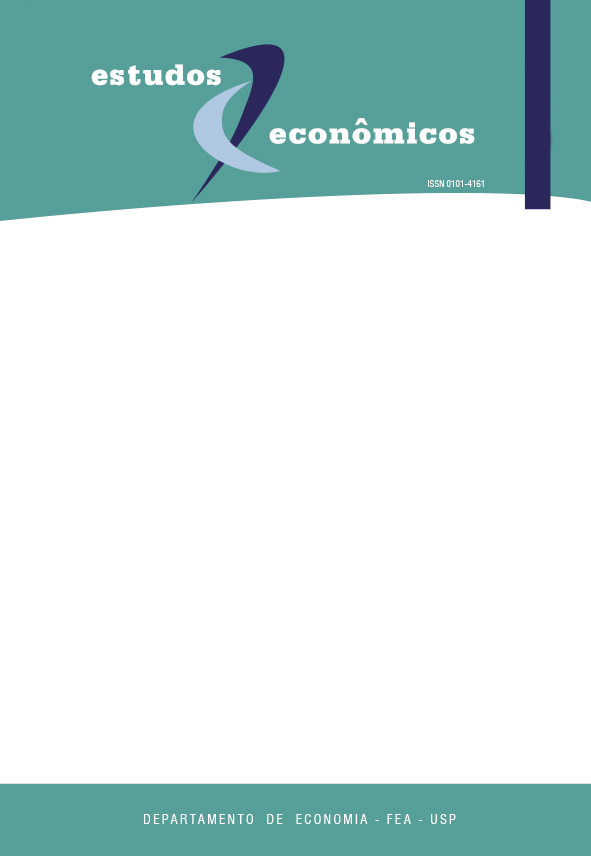Liberalização da conta de capitais e inflação: a experiência brasileira no período pós-real
DOI:
https://doi.org/10.1590/S0101-41612006000100007Keywords:
inflation, capital account liberalization, credibilityAbstract
In the 1990s the idea that capital account liberalization represented a mechanism for disciplining the conduction of the monetary policy in the search for price stability was developed. Based on this argument, a new version of Gruben e McLeod's (2001) model applying a dynamic public debt constraint to the monetary authority's utility function is made. Furthermore, an empirical analysis (through application of VAR) was made for the Brazilian case with the objective of evaluating if the increase in the capital account liberalization after the introduction of the Real Plan contributed to price stability. The findings denote that a decrease in the capital account liberalization is capable of attenuating inflationary pressure and that the duration of this effect depends on the exchange regime used.Downloads
References
Agénor, P.; Montiel, P. Development macroeconomics. New Jersey: Princeton University
Press, 1996.
Barro, R. J.; Gordon, D. Rules, discretion and reputation in a model of monetary
policy. Journal of Monetary Economics, 12, North-Holland, p. 101-121, 1983.
Bartolini, L.; Drazen, A. Capital account liberalization as a signal. The American
Economic Review, v. 87, n. 1, p. 138-154, March 1997.
Berger, H.; Haan, J. de; Eijffinger, S. C. W. Central bank independence: an update
of theory and evidence. Journal of Economic Surveys, v. 15, n. 1, p. 3-40, 2001.
Boyd, J. H.; Smith, B. D. Capital market imperfections, international credit markets
and nonconvergence. Journal of Economic Theory, v. 73, n. 2, p. 335-364, 1997.
Calvo, G. A.; Reinhart, C. Fear of floating. The Quarterly Journal of Economics, v. 117, n. 2, p. 379-408, 2002.
Cardoso, E.; Goldfajn, I. Capital flows to Brazil: the endogeneity of capital controls. IMF working paper nº 115, September 1997.
Chinn, M.; Ito, H. Capital account liberalization, institutions and financial development: cross country evidence. NBER, n. 8967, June 2002.
Cukierman, A. Central bank independence and monetary control. The Economic Journal, v. 104, n. 1, p. 437-448, November 1994.
Dornbusch, R. Capital controls: an idea whose time is past. In: Kenen, P. (ed.), Should
the IMF pursue capital account convertibility? Princeton Essays in International Finance, n. 207. Princeton University Press, 1998.
Drazen, A. Political economy in macroeconomics. Princeton University Press, 2000.
Edwards, S. Capital mobility and economic performance: are emerging economies different? NBER, n. 8076, January 2001.
Eichengreen, B. International monetary arrangements for the 21st century. Washington,
D.C.: The Brookings Institution, 1994.
Eichengreen, B; Tobin, J.; Wyplosz, C. Two cases for sand in the wheels of international
finance. The Economic Journal, v. 105, n. 428, p. 162-172, January 1995.
Enders, W. Applied econometric time series. John Wiley & Sons, 1995.
Fischer, S. Exchange rate regimes: is the bipolar view correct? Journal of Economic Perspective, XV, p. 3-24, 2001.
Frankel, J. No single currency regime is right for all countries or at all times. NBER Working Paper 7338, 1999.
Friedman, M. The role of monetary policy. American Economic Review, p. 1-17, March
Gruben, W.; McLeod, D. Capital account liberalization and inflation. Economics Letters, v. 77, n. 2, p. 221-225, 2002.
Gruben, W.; McLeod, D. Capital account liberalization and disinflation in the 1990s. Federal Reserve Bank of Dallas, Center for Latin American Economics, Working Paper 0101,
Kim, W. Does capital account liberalization discipline budget deficit? Review of International
Economics, v. 11, n. 5, November 2003 (forthcoming).
Kydland, F. E.; Prescott, E. C. Rules rather than discretion: the inconsistency of optimal plans. Journal of Political Economic, v. 85, n. 3, p. 473-492, 1977.
Levy-Yeyati, E.; Sturzenegger, f. Classifying exchange rate regimes: deeds versus words.
Universitá Torcuato Di Tella, 2002.
Lourenço, R. F. Regimes cambiais: panorama geral desde as crises nas economias
de mercado emergente em meados dos anos 90. Boletim Econômico. Banco de Portugal, p. 129-144, setembro 2004.
Maddala, G. S.; Kim, I. M. Unit roots, cointegration and the structural change. Cambridge
University Press, 1998.
Obstfeld, M.; Taylor, A. M. The great depression as a watershed: international capital
mobility over the long run. In: Bordo, M.; Goldin, C.; White, E. (eds), The defining
moment: the great depression and the American economy in the twentieth
century. Chicago: University of Chicago Press, 1998, p. 353-402.
Reinhart, C. M. The mirage of floating exchange rates. The American Economic Review,
v. 90, n. 2, p. 65-70, May 2000.
Rodrik, D. Who needs capital account convertibility? In: Kenen, P. (ed.), Should
the IMF pursue capital account convertibility? Princeton Essays in International Finance, n. 207. Princeton University Press, 1998.
Rogoff, K. The optimal degree of commitment to an intermediate monetary target.
The Quarterly Journal of Economics, p. 1169-1189, November 1985.
Veríssimo, M. P. Fluxos de portfólio para o Brasil no período 1995-2002: uma análise
de vetores auto-regressivos e de causalidade. Instituto de Economia, UFU, Fevereiro 2004.
Vieira, F.; Holland, M. Country risk endogeneity, capital flows and capital controls in
Brazil. Revista de Economica Política, v. 23, n. 1 (89), p. 12-38, jan-mar 2003.
Williamson, J. Exchange rate regimes for emerging markets: reviving the intermediate
option. Policy Analyses in International Economics 60. Washington, DC: Institute for International Economics, September 2000.
Downloads
Published
Issue
Section
License
Copyright (c) 2006 Helder Ferreira de Mendonça, Manoel Carlos de Castro Pires

This work is licensed under a Creative Commons Attribution-NonCommercial 4.0 International License.
By submitting an article, the author authorizes its publication and attests that it has not been submitted to any other journal. The original article is considered final. Articles selected for publication are proofread for grammatical and orthographic errors. The journal does not pay rights for published articles. The Institute of Economic Research from the School of Economics, Business and Accounting of the University of São Paulo (Instituto de Pesquisas Econômicas da Faculdade de Economia, Administração e Contabilidade da Universidade de São Paulo) owns the journal's copyright.





 Atualizado em 14/08/2025
Atualizado em 14/08/2025